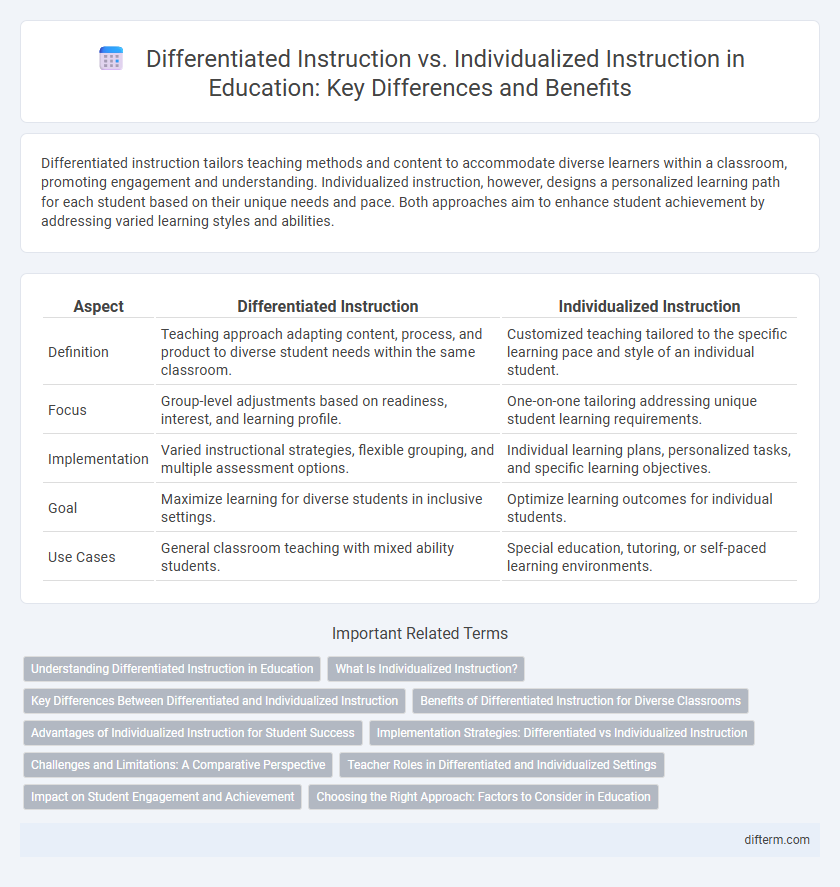Differentiated instruction tailors teaching methods and content to accommodate diverse learners within a classroom, promoting engagement and understanding. Individualized instruction, however, designs a personalized learning path for each student based on their unique needs and pace. Both approaches aim to enhance student achievement by addressing varied learning styles and abilities.
Table of Comparison
| Aspect | Differentiated Instruction | Individualized Instruction |
|---|---|---|
| Definition | Teaching approach adapting content, process, and product to diverse student needs within the same classroom. | Customized teaching tailored to the specific learning pace and style of an individual student. |
| Focus | Group-level adjustments based on readiness, interest, and learning profile. | One-on-one tailoring addressing unique student learning requirements. |
| Implementation | Varied instructional strategies, flexible grouping, and multiple assessment options. | Individual learning plans, personalized tasks, and specific learning objectives. |
| Goal | Maximize learning for diverse students in inclusive settings. | Optimize learning outcomes for individual students. |
| Use Cases | General classroom teaching with mixed ability students. | Special education, tutoring, or self-paced learning environments. |
Understanding Differentiated Instruction in Education
Differentiated instruction in education tailors teaching methods and materials to accommodate diverse learners within a single classroom, addressing varied readiness levels, interests, and learning profiles. It contrasts with individualized instruction, which designs specific learning plans for each student, often working one-on-one to target unique needs. Effective differentiated instruction involves flexible grouping, varied assessment methods, and adaptive content to optimize student engagement and mastery.
What Is Individualized Instruction?
Individualized instruction tailors learning experiences to meet the unique needs, pace, and learning styles of each student, ensuring personalized educational goals. This approach contrasts with differentiated instruction by offering custom content, strategies, and assessments based on individual learner profiles rather than group-based modifications. Key components include continuous assessment, adaptive lesson plans, and targeted interventions that support optimal student growth and mastery.
Key Differences Between Differentiated and Individualized Instruction
Differentiated instruction tailors teaching methods, content, and assessments to address diverse learning styles and readiness levels within a single classroom, while individualized instruction customizes learning plans for each student's unique needs and pace. Differentiation often involves flexible grouping and varied activities, whereas individualization requires one-on-one attention and personalized goals. Understanding these distinctions helps educators implement more effective strategies to enhance student engagement and achievement.
Benefits of Differentiated Instruction for Diverse Classrooms
Differentiated instruction enhances learning outcomes by addressing varied student readiness levels, interests, and learning profiles within a diverse classroom, promoting inclusive education. It fosters engagement and motivation through tailored teaching strategies that support multiple intelligences and cultural backgrounds. This approach improves academic achievement and social-emotional development by providing flexible pathways and scaffolded support for all learners.
Advantages of Individualized Instruction for Student Success
Individualized instruction tailors learning experiences to each student's unique needs, pacing, and interests, fostering greater engagement and motivation. By addressing specific strengths and weaknesses, it promotes deeper understanding and retention of content, which can lead to improved academic performance. This personalized approach also supports diverse learning styles, increasing student confidence and encouraging self-directed learning.
Implementation Strategies: Differentiated vs Individualized Instruction
Differentiated instruction involves creating multiple learning paths within the same classroom by varying content, process, and product based on students' readiness, interests, and learning profiles, often utilizing flexible grouping and tiered assignments. Individualized instruction, in contrast, emphasizes tailor-made educational plans for each student, leveraging personalized pacing and one-on-one teaching to address unique learning needs and goals. Effective implementation of differentiated instruction requires ongoing assessment and dynamic lesson adjustments, while individualized instruction demands detailed learner analysis and customized resource allocation to optimize student outcomes.
Challenges and Limitations: A Comparative Perspective
Differentiated instruction faces challenges in balancing diverse student needs within a single classroom, often requiring extensive planning and resource allocation that can overwhelm educators. Individualized instruction, while tailored to each student's unique learning pace, demands significant time and technological support, potentially limiting scalability in large or under-resourced environments. Both approaches encounter limitations related to assessment accuracy and the difficulty of consistently meeting varied cognitive, emotional, and social learning requirements across diverse student populations.
Teacher Roles in Differentiated and Individualized Settings
Teachers in differentiated instruction settings act as facilitators who design varied learning activities based on students' abilities, interests, and learning styles within a shared curriculum. In individualized instruction, educators adopt a more personalized role, tailoring content, pace, and methods to meet each student's unique needs and learning goals. Both approaches require continuous assessment and adaptability to optimize student engagement and achievement.
Impact on Student Engagement and Achievement
Differentiated instruction enhances student engagement by tailoring teaching methods to diverse learning styles within a classroom, fostering collaboration and motivation. Individualized instruction targets specific student needs with customized pacing and content, directly boosting achievement for learners requiring focused support. Both approaches improve academic outcomes by addressing variability in readiness, interests, and learning profiles effectively.
Choosing the Right Approach: Factors to Consider in Education
Differentiated instruction tailors teaching methods to diverse student groups based on shared characteristics, while individualized instruction customizes learning plans to meet each student's unique needs and pace. Factors influencing the choice include class size, resource availability, student learning profiles, and specific educational goals. Educators must assess these elements to implement the most effective strategy for promoting engagement and academic success.
differentiated instruction vs individualized instruction Infographic

 difterm.com
difterm.com